Students Build Distinctive Aquarium for ESU’s Schisler Museum
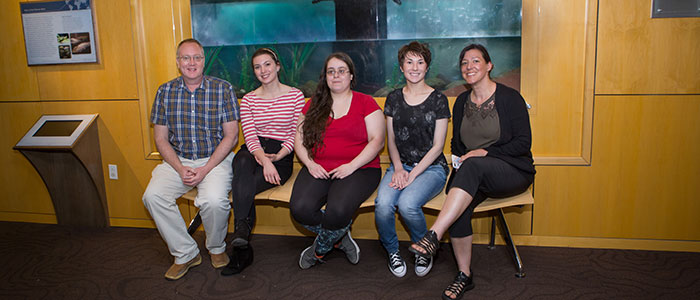
Posted by: Elizabeth Richardson on May 25, 2018, One Comment
It’s hard to know if the minnows, killifish and other small creatures will appreciate the innovative thinking that has gone into creating a unique aquarium as their habitat at the Schisler Museum of Wildlife & Natural History on campus. But generations of school children and other museum-goers will.
The museum and East Stroudsburg University’s art + design and biological sciences departments collaborated to reimagine and rebuild an 8-foot long aquarium near the entrance to make it a better ecosystem for the fish and more reflective of the nearby Delaware Water Gap.
Along the way, it has provided the students involved with lessons in problem-solving and perseverance in the face of setbacks. The hope is to have the 360-gallon tank back in service by summer’s end and full of aquatic life indigenous to the Delaware River. The aquarium will have a student-designed floor and artificial plants that will be better for fish, plus a stunning student-created backdrop.
Darlene Farris-LaBar, professor of art + design, who spearheaded the project along with James Hunt, associate professor of biological sciences, said having students from both disciplines working together has been “a wonderful collaboration.”
Housed on the ground floor of the Warren E. ’55 and Sandra Hoeffner Science and Technology Center, the Schisler Museum was created in 2014 with 140 taxidermic specimens of wildlife species from North America and abroad that were donated by ESU alumni Arthur and Fannie Schisler. It opened to the public in 2016 and now attracts scores of school groups, Scout troops and community organizations.

Curator Catherine Klingler said the reconstructed aquarium will help teach museum-goers about the vitality of the region’s habitats.
“It brings in that local element of how important the Delaware River is to us in this ecosystem and we get to highlight some of the species as part of our tours,” Klingler said. “The Pocono Mountains is part of a zone that has some of the highest biodiversity in the country and in the world.”
Last summer, Evelyn Barone, a senior double major in biology and art + design and Kristina Turturiello, who graduated this month with a Bachelor of Fine Art, started working with Farris-LaBar on the aquarium. Both students received stipends from a research program created by the provost’s office.
The initial plan was to use a 3D printer from ESU’s Stratasys Super Lab to create a new floor and artificial plants for the tank. But Farris-LaBar and Barone discovered the 3D plastic material they hoped to use was harmful to fish.
“So that created a lot of stumbling blocks for us,” Farris-LaBar said.
Over the school year, they consulted with Hunt and some of his biology students about the floor and what the plants should look like. Farris-LaBar involved students from her spring ART 154 Three-Dimensional Design class.
They also reached out to a Macungie, Lehigh County company called Smooth-On that works with the National Aquarium in Baltimore to create artificial plants that are safe for fish.
“All the seaweed and all that stuff is fake though it looks real in the aquarium,” Farris-LaBar said. Plant replicas make it easier to keep the aquarium clean for the fish.
They settled on using more than 200 pounds of clay to sculpt the tank floor into a kind of topographical map. Then they pressed vacuum forming sheets over the top of the clay. From there, they added layers of fish-safe material over the sheets and painted it.
Barone said the experience challenged her problem-solving skills.
“The average product goes through between 23 and 24 designs before they settle on one,” Barone said. “You want to fail fast, you don’t want to spend six months on something and find out it’s not going to work.”
Meanwhile, Kristina Turturiello ’18, consulted with Barone, Dr. Hunt and his biology students to create the backdrop for the aquarium that gives it the look of a river bottom with sunlight shining through. She painted the scene in oil paint, then had it printed on vinyl at four times the original size.
“The backdrop is absolutely gorgeous,” Hunt said. “It has to evoke a feeling of being underwater and she has a nice lighting effect in it that makes you feel that it’s shallower in one part and deeper in the other part.”
Ultimately, the designers were able to use 3D prints under a vacuum forming machine to create molds for fish-safe silicone plants.
“This will make it easier to maintain the tank,” Hunt said. “We can put on something called an ultraviolet sterilizer. What this does is take water from the tank and basically zaps all of the harmful bacteria and pathogens so that the water is healthy. So fish are not going to get sick as much.”
Farris-LaBar said the reconstructed aquarium should impress the students’ future employers and clients. Hunt sees the project as great example of how students in different fields can learn from each other.
“Sometimes students and parents wonder what’s the value of a liberal arts education, what’s the value of taking all these courses outside their discipline,” Hunt said. “And the value is that you start to think and connect in ways you can’t possibly do if you become narrowly focused. You really do learn by a wealth of classes, a wealth of experiences, how to put things together.”
Summer hours at the Schisler Museum of Wildlife & Natural History and the McMunn Planetarium begin June 1 when the museum will be open 10 a.m. – 4 p.m. Tuesdays – Saturdays.
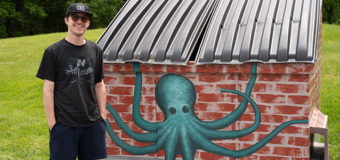
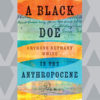
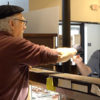

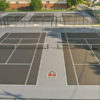
ARTHUR & FANNIE SCHISLER
Posted May 27, 2018 at 4:46 PM
VERY PLEASED TO READ THIS NEWS. THERE HAS BEEN TALK FOR YRS, HOWEVER IS HAS NOW COME TO BE. THANKS GANG THE FINAL TOUCH.
ART & FANNIE